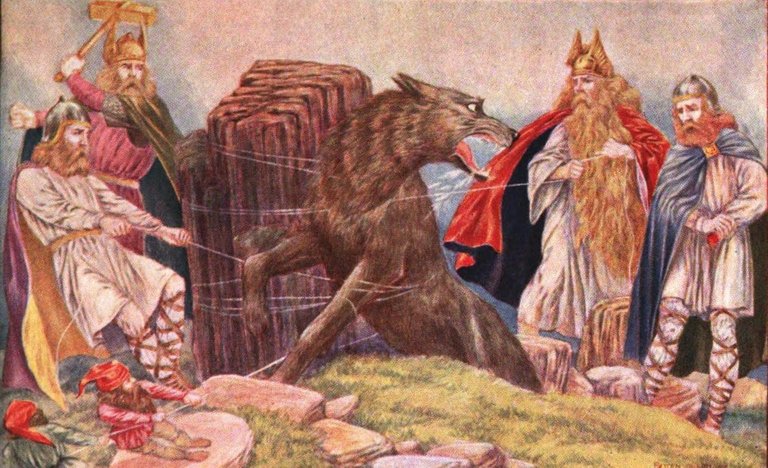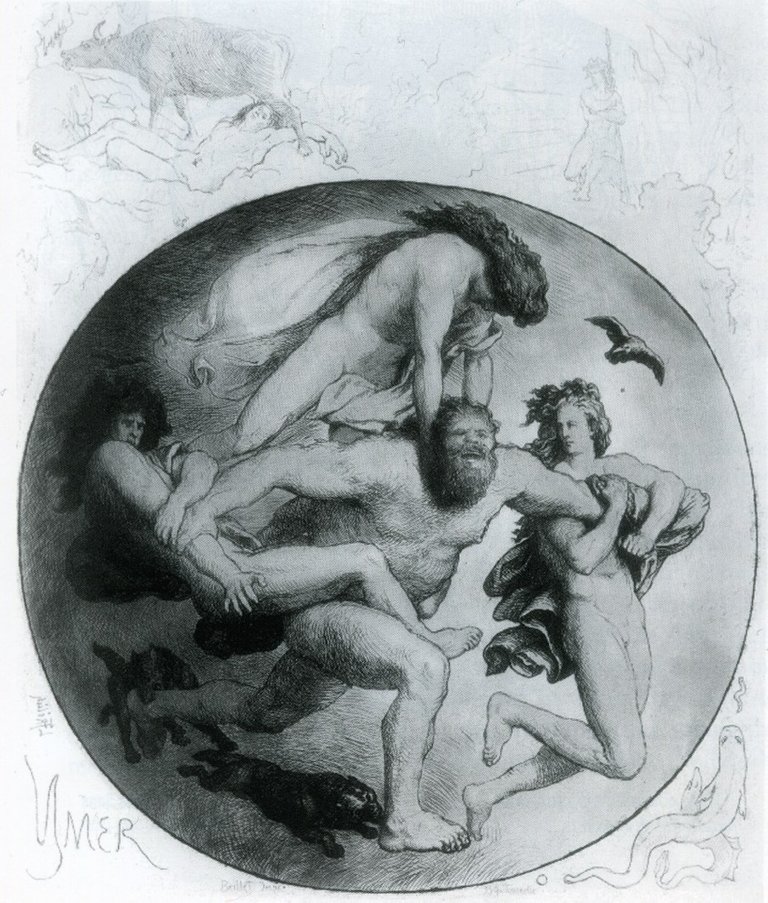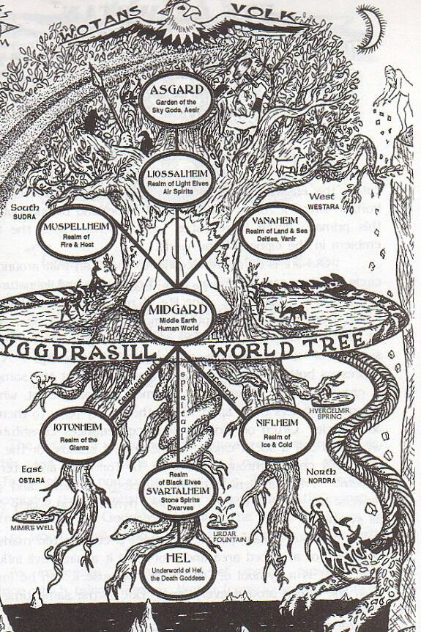Hello, dear @adsactly readers and lovers of folklore. Today I want to take you on an epic journey to discover the many myths about giants, as this is a domain I find most fascinating. Basically all people have legends about giants, from the cosmogonic myths to the simple bed-time stories. The Bible, Norse mythology, Greek legends, Native-American stories as well as Hindu myths, all speak of fearsome giants who existed somewhere at the dawn of times and most are actively involved in the creation of the Universe. And it makes you wonder how come people living so far apart and in different eras came up with stories that bear so many similarities? Also, it raises the tantalizing question - were there ever giants roaming the Earth and if there were what happened to them?
The first episode in this series is dedicated to the giants in Norse mythology, as in these stories they are depicted as a race of giants, rather than isolated characters as is the case in other people’s myths. Also, in Northern legends, giants are personally involved in the creation of our world.
According to Norse mythology, in the beginning there was … nothing. Only the ‘yawning emptiness’, Ginnungagap, where deep down lay the Well of Life. Then ice started to pile up mysteriously on this well until it took the form of Ymir, the greatest of all Giants, father of the entire race of giants. The story tells us Ymir was fed by the magic cow Audumla, which obviously is very similar to the Greek legend of Zeus who was nursed by the goat Amalthea.
The magic cow plays an important part in the creation of the world as she licked the ice around the well to reveal the first Aesir, Buri, grandfather to the great god Odin.
Now, Ymir was evil, as indeed are most Giants in all legends everywhere. Ymir is described as the creator of the fearsome Frost Giants, who came into being from the sweat of his armpit.
Most cosmogonic myths involve some sort of fight for power - in Norse lore, Odin and his brothers, Vili and Ve, grow tired of all the violence the ever-increasing population of Frost Giants caused and take up arms. They slay Ymir and all the giants drown in his blood. Only Bergelmir and his wife escape by seeking refuge on a boat made from a hollowed tree-trunk, which is, of course, a parallel to the Biblical flood and Noah’s Ark. Some stories have it that Odin allowed Bergelmir to live as he was not like the other giants, but he was wise and clever. While Noah is saved to repopulate the earth with humans, and all the animals sheltered on the Ark, Bergelmir escapes to continue the race of giants who never lost their hatred of the gods.
Odin and his brothers threw the body of Ymir into the void of Ginnungagap and his remains became the world we live in. His ice-blood became the rivers and seas, while from his flesh the dry land was made. His bones turned into mountains, which the gods used as a barrier against Jotunheim, the land of the giants. Actually, the name Jotunheim comes from the term ‘jotunn’, which in Norse mythology is used to refer to the giants. Ymir’s scattered teeth became the rocks and gravel on earth. The sky, according to Norse legends, is made of Ymir’s skull, held above the earth by four dwarfs. Sparks were used to make the stars we see at night.
Part of the newly-created land was Midgard, the Middle Earth, which belonged to mankind and Odin wanted to make it beautiful and fruitful. From Ymir’s curly hair he made trees, and from his eyebrows the grass and flowers were fashioned.
Such a violent creation myth is by no means unique. After all, slayings are common in Greek mythology. There is also a Babylonian myth about the hero Marduk, who kills the chaos-dragon Tiamat, then splits her carcass in two to make heaven and earth.
The story of Ymir is attested for the first time in a collection of 13th century stories, but many scholars have tried to find a much older origin for the primeval giant. Comparative mythology scholars consider Ymir to be an echo of a Proto-Germanic being named Tuisto (or Tuisco), which is described by Tacitus in his 1st century work ’Germania’. While the two characters bear functional similarities, it is hard to say if they refer to the same being as there is no mention of Tuisto being as evil as Ymir is described.
The Giants existence in Norse mythology is very complicated, as for all their evilness, they interact with the Aesir in many instances. One of the most fascinating gods in Norse mythology, Loki, is himself the son of the giant Farabauti, the ‘cruel striker’ associated with wildfires, and Laufey. While he is the god of fire, a trait inherited from his father, Loki usually goes by the name Loki Laufeyjarson, the son of Laufey.
In a previous folklore post about the significance of apples in old legends, we mentioned the story of Idun and the apples of youth, in which Loki plays an essential part. It was after bringing back Idun that Loki, the son of giants, is granted a place in Asgard, among the Aesir. However, as there was always an evil streak in him, after many schemes and tricks, the gods decided to have him bound in a dark cave where he waits Ragnarok the final battle between the gods and the giants. According to lore, the gods placed a venomous snake above Loki’s head to drip poison on him. It is his devoted second wife Sigunn, who holds a cup up high to catch the poison drops. However, when she turns to empty the cup, the poison falls on Loki’s head, causing him to twitch in pain - and the whole world to shake in what we call earthquakes.

Like his father, Loki, the wolf Fenrir was also bound by the Gods
source
No longer considered one of the Aesir, Loki is to lead the army of evil in the final battle. His children by the giantess Angrboda also play an important part at Ragnarok. His son, the monstrous wolf Fenrir, is set to kill mighty Odin at Ragnarok.
Another interesting fact about the giants of Norse mythology is that they are described as having fathered all sorts of evil creatures, like werewolves and trolls, which appear as frequent characters in many popular stories and legends. While their troll children are often portrayed as dumb, the giants of Norse mythology are not known for being stupid. However, in other cultures, the giants are usually presented as quite dim, as we shall see in future articles.
Post authored by @ladyrebecca.
References: Myths of the Norsemen, The Encyclopedia of Mythology.
Click on the coin to join our Discord Chat

Witness proposal is here:
Go To Steem Witness Page
In the bottom of the page type: adsactly-witness and press vote.

Use small letters and no "@" sign. Or, click here to vote directly!
Thank you!




Interesting this new series that you plan to develop. In Venezuela there is an indigenous myth that talks about how mountains and trees were made in one part of the country. It is said that those mountains and those immense trees were giants that tried to ascend to heaven without the permission of the Great God. When he realized what the giants wanted to do, he immobilized them. Those who visit the Great Savannah will see that the mountains and trees are impressive in height and some reach the sky. Watch out for the next deliveries. Greetings, @ladyrebecca
That's quite an interesting story, thanks @nancybriti!
I really liked this post very much and I'll be looking forward to reading the whole series. I have also been reading the comments of @marcybetancourt, @hlezama and @josemalavem, which introduce very interesting concerns, appreciations and discussion points.
I will add my contribution to this fascinating conversation.
The mythological theme has contributed a lot to the development of fantasy literature. Two of my favorite giants are Gargantua and Pantagruel, protagonists of François Rabelais' satirical novel originally titled The Terrible Life of the Great Gargantua (they were actually five books published between 1534 and 1552, according to Wikipedia - I love her!). These characters are described as drunk, greedy and not very moral. The book is hilarious, morbid and literally magnificent.
There is also another giant ( really, son of a giant and human) of fantastic literature that totally stole my heart: Hagrid, the kind giant of the Harry Potter saga.
It's a rich mythology and @ladyrebecca has portrayed it well in this introduction. Thank you.
And thanks to @adsactly for publishing it.
Well, who doesn't love Hagrid?
Only a being with no heart in his chest, @ladyrebecca! :D
I love mythology themes. This publication is super special because you write a little known but very striking mythology: the Nordic. I have often asked myself the same question you pose at the beginning. How can there be so many similarities in such distant and different cultures? Did the giants really exist? Are they always the giant evil beings? I hope in future readings to find beings of great size and with great nobility, who were misunderstood and therefore violent. A question @ladyrebecca: if we believe that the giants at some point populated the earth, why did they become extinct? What does literature and folklore tell you? Greetings and thanks for the article @ladyrebecca and @adsactly
Good question. I don't know the answer, but I will try to have a look at the different theories out there, those that seems valid, because it's a domain where it's very easy to fall into all kind of speculation.
As for the giants' character, their representation as gentle is a modern, more literary one... but if at some point 'normal' humans coexisted with giants it's easy to understand how they got a bad reputation, we're always afraid of people that are different.
Fantastic series. Aptly chosen premiere with the men of the north, who even for modern standards are still considered giants.
Very informative and entertaining. It is never easy to write about something as complex and volatile as mythology. There are always more than one version of the same myth with rather radical differences from one another.
It makes sense that our world resulted form such a messy beginning and from such malign seeds. That would explain our infinite capacity to create and foment evil and destruction.
Interesting. Northern men are truly regarded as giants even today.
You have chosen some interesting figures: the giants, for your series, @ladyrebecca. Nordic mythology (which in some books is simply called "Germanic") is very little known to those of us who inhabit the American continent. It is striking how, in some way, mythology gives account of the ancient glaciations that originated much of later life, with that account of the melting of ice and warm winds. It is curious that the first living being is a giant and, in addition, associated with evil, the original component of the universe, seems to be postulated. And that, in addition, Odin, the most widespread Germanic god, be the son of giants, descendant of Ymir, then.
About the coincidence in the cultures of figures, stories, etc., I think it has an explanation in C. G. Jung's proposal: the collective unconscious and the archetypes, as I have commented before here. Thank you for this series you start today, @ladyrebecca; I'll keep an eye on it. Greetings.
A nice bit of Norse mythology. Thanks for the exposé.